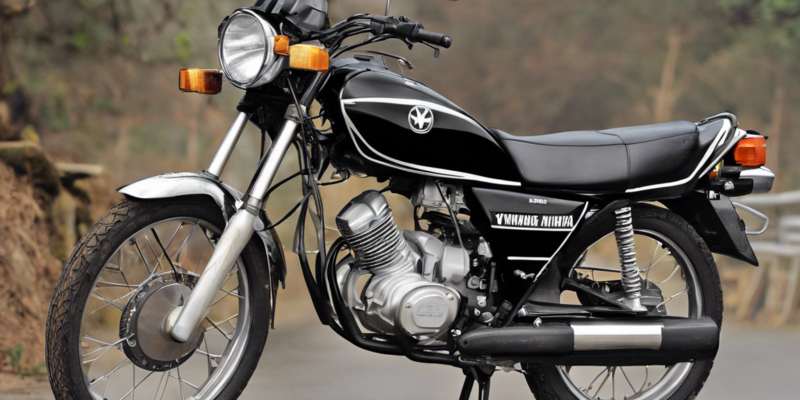
Exploring the Yamaha Rx 100 225cc Motorcycle
Introduction
The Yamaha RX 100 225cc motorcycle is a classic, highly sought-after bike known for its performance and design. Originally launched in the 1980s, the RX 100 quickly became popular among motorcycle enthusiasts in India and abroad. In this blog post, we will delve into the various aspects of this iconic motorcycle, from its history and specifications to its enduring legacy among riders and collectors.
History of the Yamaha RX 100
The Yamaha RX 100 was introduced in the 1980s and quickly gained a reputation for its powerful performance and sleek design. It featured a 98cc, two-stroke engine that delivered impressive speed and acceleration, making it a favorite among young riders looking for an adrenaline rush. The RX 100 was also known for its distinctive exhaust note, which added to its appeal among motorcycling enthusiasts.
Technical Specifications
The Yamaha RX 100 was powered by a 98cc, single-cylinder, two-stroke engine that produced around 11 horsepower. It had a 4-speed manual transmission and a top speed of 100 km/h. The bike featured a telescopic fork suspension in the front and swingarm suspension in the rear, providing a smooth and comfortable ride. The RX 100 was equipped with drum brakes on both the front and rear wheels, ensuring reliable stopping power.
In later iterations, Yamaha introduced the RX 135 and RX-Z models, which featured larger displacement engines and enhanced performance. The RX 135 came with a 132cc engine producing more power, while the RX-Z had a 132cc engine with a 5-speed transmission for improved acceleration and top speed.
Legacy and Collectibility
Despite being discontinued in the early 2000s, the Yamaha RX 100 continues to hold a special place in the hearts of motorcycle enthusiasts. Its timeless design, coupled with its reputation for performance and reliability, has made it a sought-after collector’s item. Restored RX 100 motorcycles command premium prices in the used bike market, with enthusiasts willing to pay top dollar for a well-maintained specimen.
The RX 100’s popularity has also led to the formation of dedicated fan clubs and online forums where owners and enthusiasts can share their experiences and knowledge about this iconic motorcycle. Its cult status is a testament to Yamaha’s engineering prowess and design philosophy that has stood the test of time.
FAQs
- Is the Yamaha RX 100 still in production?
-
No, Yamaha discontinued the RX 100 series in the early 2000s.
-
What makes the Yamaha RX 100 popular among riders?
-
The RX 100 is known for its powerful performance, sleek design, and distinctive exhaust note.
-
Are spare parts readily available for the Yamaha RX 100?
-
While some spare parts may be challenging to find due to the bike’s age, there are aftermarket suppliers and enthusiasts who specialize in restoring RX 100 motorcycles.
-
Can I legally ride a Yamaha RX 100 on the roads today?
-
The legality of riding an RX 100 on public roads depends on the local regulations and emissions standards. It is advisable to check with local authorities before riding the bike.
-
What should I look for when buying a used Yamaha RX 100?
-
When buying a used RX 100, check the overall condition of the bike, including the engine, frame, suspension, brakes, and electrical system. Additionally, verify the bike’s documents and service history to ensure it has been well-maintained.
-
How can I restore a Yamaha RX 100 to its original condition?
-
Restoring an RX 100 requires sourcing genuine spare parts, working with experienced mechanics, and paying attention to detail. There are restoration guides and forums online that can provide valuable insights and tips.
-
What are some common modifications made to the Yamaha RX 100?
-
Enthusiasts often modify the exhaust system, suspension, and carburetor to enhance the RX 100’s performance and aesthetics. However, it is essential to ensure that any modifications comply with local regulations.
-
Is the Yamaha RX 100 a good choice for beginners?
-
The RX 100’s powerful engine and lightweight design may not be suitable for inexperienced riders. It is recommended that beginners start with a smaller, less powerful motorcycle to build their skills before transitioning to a bike like the RX 100.
-
How does the Yamaha RX 100 compare to modern motorcycles in terms of performance?
-
While the RX 100 may not match the performance of modern motorcycles in terms of speed and technology, it holds its own in terms of character, nostalgia, and sheer riding pleasure. It offers a raw and engaging experience that is hard to find in newer bikes.
-
What is the market value of a well-maintained Yamaha RX 100?
- The market value of a well-maintained Yamaha RX 100 varies depending on factors such as the bike’s condition, mileage, originality, and demand in the market. Prices can range from a few thousand dollars to significantly higher for rare or showroom-quality models.
